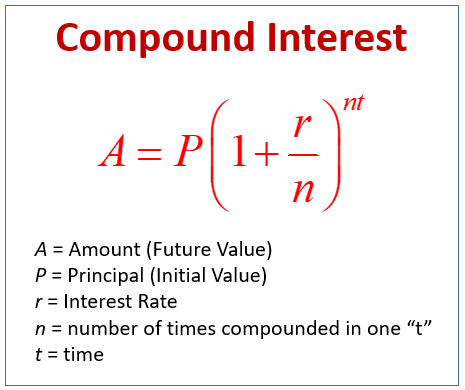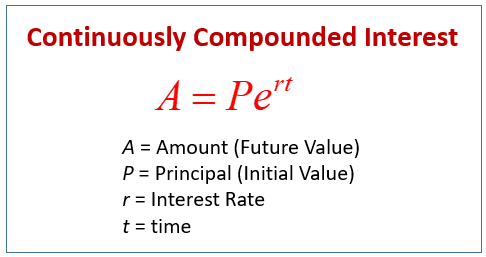Compound Interest & Continuously Compounded Interest
These lessons help Algebra students learn how to solve word problems using the compound interest formula, how to solve continuously compounded interest problems, and how to calculate the effective rate of return.
Related Pages
Interest Word Problems
Investment Word Problems
More Algebra Lessons
Compound Interest Formula
The following diagram gives the Compound Interest Formula. Scroll down the page for more examples and solutions on how to use the compound interest formula.

The compound interest formula for compounded interest is:
A = P(1 + r/n)nt
where A = Future Value
P = Principle (Initial Value)
r = Interest rate
n = number of times compounded in one t
t = time
Interest Word Problems
Interest Problems
Simple Interest Word Problems
Compound Interest Word Problems
Compound Interest & Continuously Compound Interest
Investment Word Problems
Printable & Online Algebra Worksheets
Examples:
-
Matt is saving for a new car. He invests $5,000 into an account that pays 3% interest a year and is compounded monthly.
(a) How much will he have after 5 years?
(b) How long will it take for his investment to double? -
Matt is planning to buy a car in three years. He wants to invest $5,000 now and hopes to have $6,000 to spend on the car when he buys it. What interest rate would he need if his investment is compounded monthly?
What is the compound interest formula for continuously compounded interest?
The following diagram gives the Continuously Compounded Interest Formula. Scroll down the page for more examples and solutions on how to use the Continuously Compounded Interest formula.

The compound interest formula for continuously compounded interest is
A = Pert
where A = Future Value
P = Principle (Initial Value)
r = Interest rate
t = time
Examples:
-
Lindsey invests $1,000 into an account with 4% per year continuously compounded interest. How much will she have after 10 years? How long will it take for her investment to double?
-
Tony and Matt both invest $5,000 in an account that receives 3% interest annually for 10 years. Tony invests in an account that is compounded monthly. Matt invests in an account that is compounded continuously. Who made the better investment?
How to calculate the effective rate of return?
Example: If $2,500 is invested at 5% compounded monthly, what is the effective rate of return. What is the effective rate of return if this investment is compounded semiannually?
How to solve word problems involving compound interest and continuously compounded interest?
Examples:
-
Determine the principal P that must be invested at 7% compounded monthly, so that $200,000 will be available for retirement in 15 year.
-
What amount (to the nearest cent) will an account have after 10 years if $175 is invested at 6.5% interest compounded continuously?
-
If $9900 is invested at 14% per annum compounded continuously, how long will it take before the amount is $1,400? Round the answer to two decimal places.
Check out other Algebra Word Problems
Age Word Problems, Average Word Problems, Coin Word Problems, Consecutive Integer Word Problems, Digit Word Problems, Distance Word Problems, Fraction Word Problems, Geometry Word Problems, Integer Word Problems, Interest Word Problems, Lever Word Problems, Mixture Word Problems, Money Word Problems, Motion & Distance Word Problems, Number Sequence Word Problems, Proportion Word Problems, Quadratic Equation Word Problems, Ratio Word Problems, Symbol Word Problems, Variation Word Problems, Work Word Problems.
Try the free Mathway calculator and
problem solver below to practice various math topics. Try the given examples, or type in your own
problem and check your answer with the step-by-step explanations.

We welcome your feedback, comments and questions about this site or page. Please submit your feedback or enquiries via our Feedback page.